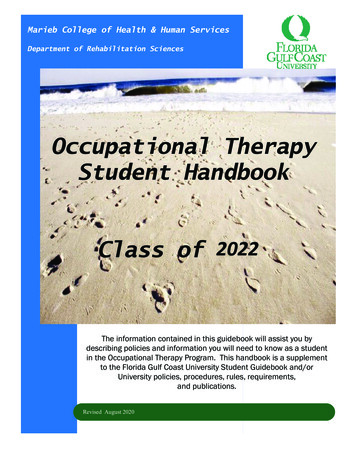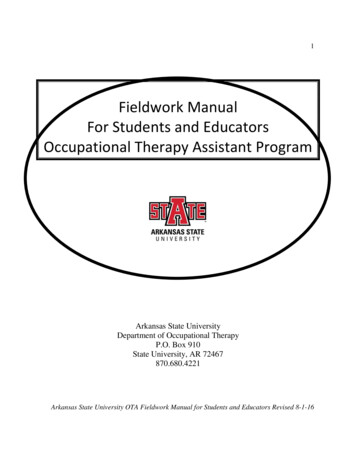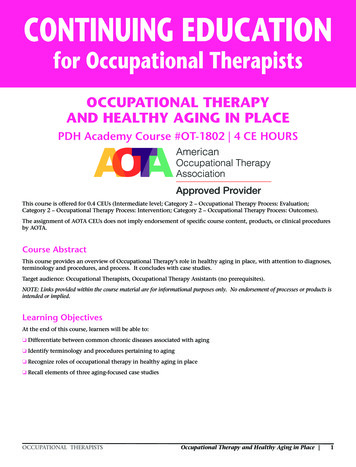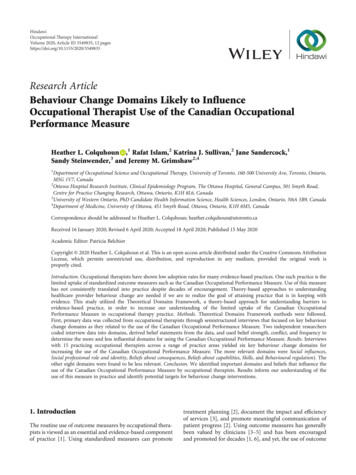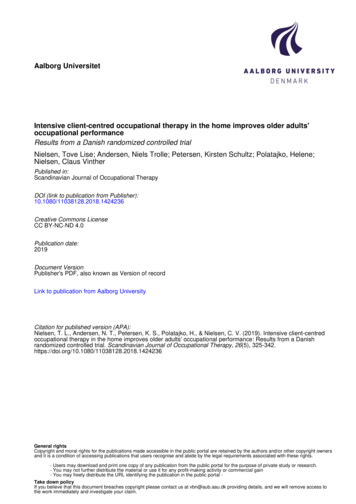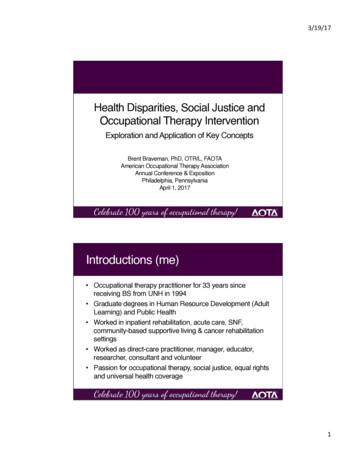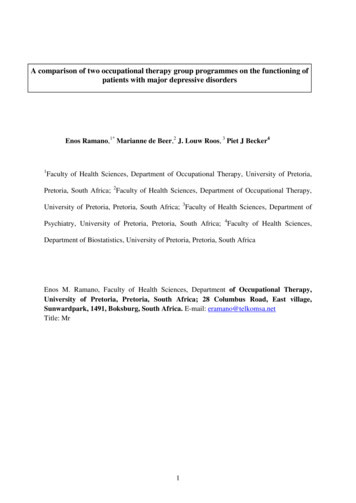
Transcription
A comparison of two occupational therapy group programmes on the functioning ofpatients with major depressive disordersEnos Ramano,1* Marianne de Beer,2 J. Louw Roos, 3 Piet J Becker41Faculty of Health Sciences, Department of Occupational Therapy, University of Pretoria,Pretoria, South Africa; 2Faculty of Health Sciences, Department of Occupational Therapy,University of Pretoria, Pretoria, South Africa; 3Faculty of Health Sciences, Department ofPsychiatry, University of Pretoria, Pretoria, South Africa; 4Faculty of Health Sciences,Department of Biostatistics, University of Pretoria, Pretoria, South AfricaEnos M. Ramano, Faculty of Health Sciences, Department of Occupational Therapy,University of Pretoria, Pretoria, South Africa; 28 Columbus Road, East village,Sunwardpark, 1491, Boksburg, South Africa. E-mail: eramano@telkomsa.netTitle: Mr1
ABSTRACTBACKGROUNDː Occupational therapists, as part of the multi-disciplinary psychiatric team,regularly include activities and or discussion groups to reduce symptoms of patients withmajor depressive disorders (MDD), and to improve their functional ability. This study set outto compare two occupational therapy group programmes. A Standard Care Plus (SCO)programme, which includes tangible activities in each of the nine group sessions, wascompared with the usual Standard Care (SCN) programme, which excludes tangible activitiesin four of the nine group sessions.METHODSː A comparative two-group parallel-study design was employed. One hundredparticipants, 50 from each occupational therapy group programme, were pre- and posttreatment tested by means of The Patient Health Questionnaire (PHQ-9). The study tookplace at the psychiatric wards of two private general hospitals in South Africa.RESULTSː The SCO had a significant improved total outcome (p 0.0071) compared to theSCN. Five items measured in the SCO, showed a statistically significant improvement. Theseitems were the following: Interest or pleasure in doing things (p 0.0145), Trouble falling orstaying asleep, or sleeping too much (p 0.0103), Feeling tired or having little energy(p 0.0365), Moving or speaking slowly or fidgeting and/or restless (p 0.0114) andThoughts that you would be better off dead, or of hurting yourself (p 0.0123).CONCLUSIONSː The results indicated that the SCO, which included tangible activities inevery occupational therapy group session in the treatment of patients with MDD, wassuperior to the SCN which excluded tangible activities in four of the nine group sessions.Key words: Major depressive disorder, occupational therapy, groups, tangible activities,occupation2
IntroductionThe lifetime prevalence of major depressive disorder (MDD) is almost 17%1 and is one ofthe fastest growing diseases worldwide.2 This disorder often occurs in people without closeinterpersonal relationships, leading to impairment in social and occupational functioning.1Major depressive disorder can therefore lead to poor quality of life3, decreased workproductivity4, high socio-economic costs5, increased mortality from suicide6 and can also beclassified as mild, moderate or severe.7Although MDD can be chronic, recurrent, devastating and disabling3, people with thisdisorder often recover if consistently and appropriately treated.7 The acute phase of MDDrequires in-hospital treatment when there is a risk of suicide or homicide and other types ofself-endangerment.1 The goal of acute therapy is to bring about complete or partial remissionof depressive manifestations.7 It was found however, that patients with MDD do not show acomplete response rate on symptom reduction and functional improvement when treatedwith medication, psychotherapy and or supportive measures alone.2,7,8 Hees, Koeter, deVries, Ooteman and Schene4 support this notion as they believe that the inclusion ofoccupational therapy groups reduces MDD symptoms and improves functional ability.Research studies by Lim, Morris and Craik9 and Sundsteigen, Eklund and Dahlin-Ivanoff10,also found that occupational therapists have a valuable contribution to make by using groupsas it gives patients with MDDs the opportunity to engage in occupations of daily life, inimproved social interaction and in communication skills.Occupational therapists have been using group therapy as their preferred treatmentmodality in mental health care practice since the origin of the profession.10In a study byDeCarlo and Mann11, as early as 1985, it was found that activity-based occupational therapygroups attained a higher level of interpersonal communication skills than groups that largelyinvolved discussions. Their study however, has several limitations and “suggest, rather than3
provide conclusive evidence that activity groups are more effective than are verbalgroups”.11 However, it appears that there has been a shift in focus from traditional activitygroups to psycho-educational or verbal groups, as the latter is perceived by occupationaltherapists as more challenging or prestigious.12According to Gutman and Raphael-Greenfield13 the occupational therapy profession hasnot adequately addressed the evaluation and treatment of depression. Furthermore, researchstudies that were carried out on patients with MDDs focussed pre-dominantly onoccupational therapy group intervention in outpatient settings. 10,14The position statement on therapeutic group-work in occupational therapy alsoexpressed its concern about the limited evidence based research on group-work by SouthAfrican occupational therapists.15 Therefore, it seems that occupational therapy groupinterventions for patients with MDD have not been adequately researched in the field ofoccupational therapy.This researcher has been offering a standard care occupational therapy groupprogramme (SCN) to patients with MDD since 1998. It separately entailed discussion groupsand activity-based groups, which took place in different therapy sessions. However, asoccupational therapists believe in the use of occupation as a means to achieve recovery16 theresearcher decided to develop an alternative occupational therapy group programme, thestandard care plus (SCO) programme, whereby a tangible activity is inherent in each grouptherapy session.A study was therefore undertaken with the aim to compare the two occupational therapygroup programmes, the SCN and the SCO, on the symptom reduction and functioning ofpatients with MDD. This article reports on one part of the study only, viz. comparison of theeffect of the SCN and the SCO on MDD symptoms reduction and functioning in patients asmeasured by the Patient Health Questionnaire (PHQ-9).4
Materials and methodsResearch designA comparative two-group parallel pre-test-/post-test study design was used to seek forobjectivity with a baseline (pre-test) and an end-line (post-test) after the intervention17 asindicated in Figure I.Pre-test measureInterventionPost-test measureGroup programme1SCNO1Pre-test measureGroup programme 2X1InterventionO1X2O2Post-test measureO2SCOFigure I: Comparative two-group parallel study designResearch siteThe study was conducted at the psychiatric wards of two private general hospitals inGauteng, South Africa. Both psychiatric wards used a multi-professional psychiatric teamapproach in which all patients admitted to the psychiatric wards received treatment that wasoffered by psychiatrists, psychologists, social workers and occupational therapists. Inaddition to individual occupational therapy interventions, the patients followed a two-weekoccupational therapy group programme that was either the SCN or the SCO. The period is inline with the suggestion of a two to four weeks treatment7.Study population and sampling strategyA convenience sampling method was employed.18 All the participants who were admittedwith the diagnosis of MDD and who consented to participate in the study were included.Each ward in the two private hospitals admitted a maximum of sixteen patients at a time. A5
sample size of 100 (50 for each group) hospitalised voluntary patients with MDD wereused.17 Some of the patients with MDD however did not complete the intervention as theywere discharged in less than two weeks owing to either the depletion of their medical aidfund or because of speedier improvement than expected.Inclusion criteriaParticipants were eligible for the study if they were (1) admitted to the psychiatric ward witha psychiatric diagnosis of MDD (moderate to severe MDD) with single or recurrent episodesaccording to the Diagnostic and Statistical Manual of Mental Disorders (DSM-5) criteria1,19,(2) voluntary patients who agreed to participate in the study as part of their hospitaltreatment and (3) the working age group that ranged between 23 to 60 years.Exclusion criteriaParticipants were excluded however if they were diagnosed with (1) other psychiatricdiagnoses in the DSM-5, except MDD1,19; if (2) MDD closely associated with comorbidity20;and (3) MDD with psychosis, adjustment disorder with depressive mood and were receivingelectro-convulsive therapy and antipsychotic medication.Ethical considerationsPrior to implementation, permission for the study was granted by the hospital managers andthe Ethics and Research Committee of the Faculty of Health Sciences at the University ofPretoria (226/2015). Ethical principles were adhered to as indicated by the following: All participants signed a written consent form before their enrolment for the study. Confidentiality was ensured by a coding system so that participants could not beidentified.6
Participants’ autonomy was respected at all times.Data collectionData was collected over a period of three months (March – June 2016). The study consistedof three phases: Phase I: Pre-testing of participants by means of the PHQ-9 Phase II:Occupational therapy group intervention of SCN or SCO, and Phase III: Post-testing ofparticipants by means of the PHQ-9 questionnaire.Phase IPre-testingThe data for this study was collected by means of the PHQ-9 questionnaire, which wascompleted by the participants themselves or with the assistance of either occupationaltherapists OT1 or OT2 who administered the questionnaire. The PHQ-9 questionnaire wasdeveloped in line with the diagnostic criteria for depression as set out by the DSM-5.21 Itrepresents the threshold for mild, moderate, moderately severe, and severe depressionrespectively.21,22 It had been studied in different settings, including general hospitals, inpatients23 and depression of chronic care patients21. It was used as a suitable and validmeasure for monitoring outcomes in the treatment of depression.21 A maximum time intervalof two weeks or less during the administration of the questionnaire was required.24 In thePHQ-9 questionnaire patients had to indicate how they had been troubled by the problemsover the last two weeks.25The PHQ-9’s sensitivity to change and specificity23, internal reliability21, externalvalidity21, internal consistency25, as a criterion and construct validity21,22,25 and utility24, andas a depression severity measure was established and confirmed with excellent psychometric7
properties. Its psychometric properties were moreover established in a South Africancontext.25The highest score of depression severity in the PHQ-9 was found in the majordepression group as it was based on the diagnosis for MDD.23 It had nine items, each ofwhich was scored 0 to 3 (0 not at all; 1 several days; 2 more than half the days and 3 nearly every day), providing a 0 to 27 severity score.25 Scores of 10, 15 and 20 representedcut-points for mild, moderate and severe MDD respectively.26 A score of 15 or more(moderately severe to severe depression), usually signified the presence of MDD and a scoreof less than 5 signified remission.22 The PHQ-9 was found to be useful and appropriate foruse in this study as it gave a baseline (pre-test) of participants prior to their involvement inthe intervention.Phase IIOccupational therapy group programmesThe participants took part in either the SCN or SCO for a period of two weeks and eachsession lasted 90 minutes per day. The purpose and content of each group are depicted inTable 1.8
Table 1: - Standard Care (SCN) and Standard Care Plus (SCO) occupational therapy groupprogramme presented by either occupational therapist A or occupational therapist BNo12Group topicGroup purposeSCNVerbal interactionGettingInitiate interactionacquaintedbetween membersStressShare thoughts onDiscussion on stressDiscussion on stressmanagementstress management tomanagementmanagement plus making aAcquiring aShare materials andskill in craftstools to create a uniqueVerbal interaction plus anadapted card gameacquire coping skills3SCOstress ballBeadwork braceletBeadwork necklaceDiscussion on assertivenessDiscussion onend product4567AssertivenessShare thoughts onassertiveness methodsassertiveness plus anto enhance self-controlassertiveness gameJacobson’s relaxation therapyRelaxationShare thoughts on andtherapylearn relaxationfollowed by Jacobsonmethodsrelaxation therapyBoard gamesWork as a team andPlaying a game of finger boardA balloon volleyball gamePlaying a game of fingerstimulate positiveboard plus a game ofemotional responsesblokusMagazine paperEncourage members toCreate a collage of memoriesCreate a collage ofcollagedisclose their thoughtswith magazine picturesmemories with a variety ofin a supportive groupart and craft materialsenvironment8CreativeEncourage members toCreate a drawing of positiveCreate a drawing ofdrawinggive general feedbackevents in the pastpositive events in the paston each other’sdrawings9PositiveGive members theWrite a positive commentWrite a positive commentfeedbackopportunity to give andabout each member on a pieceabout each member on areceive positiveof paper and place it in eachcard they have createdfeedbackmember’s envelope. Returnthemselves. Return card tothe envelope to its owner.its owner. After readingAfter reading commentscomments discuss one ordiscuss one or two commentstwo comments9
Standard Care (SCN)The SCN occupational therapy group programme had a variety of occupational therapysessions that were either activity based and/or discussion based groups as part of theintervention that was offered by occupational therapists OTA and OTB to the participants. Atangible activity was therefore not inherent in each group session. The sequence of the SCNwas graded in terms of interpersonal requirements that started in the first group session withthe initiation of interaction in which superficial personal information was shared, up to theninth session in which each one gave and received positive feedback to one another.Standard Care Plus (SCO)In the SCO, a tangible activity was inherent in each group session. The group objectives andinterpersonal requirements were exactly the same as those for the SCN.In addition the researcher ensured that for each group therapy session in both programmes(1) interpersonal communication was facilitated throughout, (2) intervention was providedconsistently in respect of the content, intensity and duration, and (3) the same structuredgroup procedure18 was followed. The group procedure comprised an orientation phase whichincluded a warm-up activity, a working phase with the main activity and a reflection anddiscussion phase.27Phase IIIPost-testingThe PHQ-9 was used and found to be relevant for determining the end line (post-test) orprogress of the participants at the end of the intervention.10
Statistical analysisTreatment groups were compared in respect of change, or improved difference, frombaseline (pre-test) to end-line (post-test) scores for MDD variables (items in the PHQ-9)using an analysis of covariance (ANCOVA) with two factors, a programme (with levels SC Nand SCO) and a hospital (with levels A and B), using pre-test scores as covariates, i.e.adjusting for baseline. The interaction term between the factors programme and hospital wasalso included when found to be significant. Testing was done at the 0.05 level ofsignificance. Integrated in the ANCOVA was a null-hypothesis that there is no differencebetween the SCN and SCO programmes. A p-value of less than 0.05 therefore meant the nullhypothesis is rejected and thus that there is indeed a significant difference in the results fromthe two programmes. The Data Summary in Table 2 reports a mean and standard deviationby treatment group of pre-test, post-test and change18 as well as predictive programmemargins adjusted for the baseline and the hospital in the form of a mean and 95% confidenceintervals for each programme.The effect size (ES) estimates were derived using Cohen’s d-statistics28. The ES estimate forthe two programmes in respect of the change from baseline (pre-testing) to end-line (posttesting) is determined as the difference in programme mean change divided by the pooledstandard deviation (SD): d (Mean change for SCO - Mean change for SCN)/SDpooled, whereSDpooled [( SD2SCO SD2SCN)/2].28 Thomas and Nelson29, interpreted an ES of 0.8 as large,0.5 as moderate and 0.2 as small.ResultsA sample size of 100 voluntary patients with MDD completed both the pre-test and post-testof the study. Their ages ranged from 23 to 60 years. The average age of participants in both11
programmes was 39.4 years, which is in line with the mean age for patients with MDD of 40years.1 The sample consisted of 86% females and 14% males. There is thus a greaterprevalence of MDD in females than in men.1 In SCN, most of the stressors were work related(24%), losses (22%), marriage (18%), relationships (16%), family problems (12%), finances(6%) and ill health (2%). In SCO, most of the stressors were family problems (24%),relationships (18%), finances (18%), marriage (12%), work related (12%), losses (8%) andill health (8%). The results of the two programmes as measured by the PHQ-9 are shown inTable 2.As can be seen from Table 2, the overall treatment regime, which included either theSCN or the SCO programmes, invariably had a positive impact on the well-being of thepatients. However, the SCO programme had a significantly better outcome compared to theSCN programme based on the total PHQ-9 items (p 0.0071). In five of the nine individualitems measured, the SCO, showed a statistically significant greater improvement than theSCN. These items were (1) interest or pleasure in doing things (p 0.0145), (3) trouble fallingor staying asleep, or sleeping too much (p 0.0103), (4) feeling tired or having little energy(p 0.0365), (8) moving or speaking slowly or fidgeting or restless (p 0.0114) and (9)thoughts that one would be better off dead, or of hurting oneself (p 0.0123).The p value of the remaining four items, numbers 2, 5, 6 and 7, indicated statistically there isnot a significant difference between the programmes although the SCO consistentlyperformed slightly better, except in the case of “concentration” where the improvementbrought about by the two programmes were the same.The above is supported by the effect size (ES), or standardised mean difference between theimprovements in the 9 items as brought about by SCO and SCN. A medium ES is in evidencefor items 1, 3, 4, 8 and 9 but only a relatively small ES for items 2, 5, 6 and 7.12
Table 2: - Data summary of the two programmes using PHQ-9 (n 100)PhQ9 - Comparison of Improvement fromSCN and SCO Programmes1. Little interest or pleasure in doing thingsPrePostImprovement Predictive programme margins Effect Sizeadjusted for baseline and(Cohen)**Intervention InterventionΔProgram( n 100)(n 100)(Pre-Post)(SCO SCN)hospitalMean SD Mean SD Mean SD P-value* MeanCId2.440 0.760 1.100 1.074 1.340 1.0221.389 1.141 1.637SCN0.01450.502.600 0.670 0.720 0.757 1.880 1.0031.831 1.583 2.079SCOSCNSCO2.740 0.527 0.940 0.935 1.800 1.125SCN2.740 0.527 0.980 0.958 1.760 1.021SCO2.480 0.789 0.540 0.613 1.940 1.038SCN2.640 0.749 1.020 0.915 1.620 1.048SCO2.420 0.731 0.600 0.904 1.820 1.082SCNSCO2.220 0.954 0.720 0.882 1.500 1.2162.180 0.896 0.480 0.762 1.700 1.2496. Feeling bad about yourself, that you are afailure, or having let yourself or your familydownSCN2.440 0.929 0.840 1.017 1.600 1.143SCO2.380 0.855 0.660 0.872 1.720 1.1077. Trouble concentrating on things; readingnewspaper or watching TVSCN2.600 0.728 0.900 0.886 1.700 0.953SCO2.360 0.851 0.660 0.798 1.700 1.0930.27631.792 1.558 2.0260.228. Moving or speaking slowly or beingfidgety or restlessSCNSCO2.160 0.997 0.780 0.910 1.380 1.0671.980 0.937 0.360 0.563 1.620 1.0080.01141.310 1.104 1.5161.690 1.484 1.8960.52SCN1.780 1.266 0.580 0.992 1.200 1.414SCO1.860 1.107 0.180 0.560 1.680 1.220SCN21.760 3.159 7.860 5.617 13.900 5.152SCO20.960 2.857 4.880 4.207 16.080 5.005SCN2.520 0.646 1.060 0.867 1.460 0.9082.120 0.689 0.680 0.713 1.440 0.8842. Feeling down, depressed or hopeless3. Trouble falling or staying asleep, orsleeping too much4. Feeling tired or having little energy5. Poor appetite or overeating9. Thoughts that you would be better offdead, or of hurting yourselfTotal10. If you checked off any problems, howdifficult have these problems made it foryou to do your work, take care of things athome or get along with other peopleSCO2.700 0.544 0.680 0.741 2.020 0.8920.12570.01030.03650.14981.778 1.539 2.0172.042 1.803 2.2811.637 1.412 1.8632.063 1.837 2.2881.531 1.283 1.7801.909 1.660 2.1571.480 1.249 1.7121.720 1.488 1.9510.310.530.430.291.578 1.320 1.8350.37291.742 1.485 2.0000.181.608 1.374 1.8421.236 1.011 1.4600.01230.00710.11251.644 1.420 1.86913.664 12.317 15.01016.316 14.970 17.6631.322 1.104 1.5411.578 1.359 1.7960.510.550.33* P-value from ANCOVA; P 0.05 denotes significant differences between Δ SCN and Δ SCO.** Effect Size Standardised group mean difference between SC N and SCOThe p value of the last item viz. 10, which focused on functioning, showed statistically nosignificant difference in the improvement associated with the two programmes and, as couldbe expected, a concomitant small effect size.13
DiscussionThis study sought to compare two occupational therapy group programmes, the SCN andSCO, conducted at two general private hospitals in South Africa. The results of the studyindicated that overall the SCO had a statistically significant (p 0.0071) better impact than theSCN programme on improving the well-being of patients with MDD as measured by thePHQ-9. The individual items that had a significant difference will be discussed next.Little pleasure or interest in doing thingsPatients with acute psychiatric illness often do not engage in meaningful activity.30 In thisstudy, occupational therapy groups allowed the participants to spontaneously engage inmeaningful activities during each group session of the SCO programme. The latter wasconsequently found to result in a statistically significant difference in improving positivelycompared to that attained with the SCN programme (p 0.0145).This finding compares favourably with that of literature reviewed on the relationshipbetween activities and health. Fane, Ramugondo, Leshoele and Coker31 who engaged theirpatients in activities found that those activities sparked creativity, cohesion, sharing andsupport, thus eliciting the patients’ interest in doing things. The nature of the activities wasalso commented on as eliciting interest in doing things.Trouble falling or staying asleep, or sleeping too muchEighty percent of hospitalised patients with MDD report trouble falling asleep or stayingasleep.32 Active engagement in a daily occupational therapy group session, as included in theSCO programme, discouraged MDDs from sleeping during the day. Participants wererequired to execute tasks which required concentration, physical energy and socialinteraction. The SCO participants also took part in relaxation therapy, which they reported as14
having reduced their stress level by calming them down. The SCN, programme which did notinclude a physical activity, but relaxation therapy only, had a significantly lower impact.Feeling tired or having little energyAustin, Mitchell and Goodwin33 emphasised that patients with MDD experienced difficultiesexerting effort due to their low energy levels. It was interesting to note in this study thatalthough participants in general experienced an improvement in their energy levels and weremotivated to engage in more meaningful activities, there was a small to medium size effectin the difference between the two programmes in favour of SCO. It was interesting to alsonote that there was spontaneous interaction elicited by activities throughout the groups ofSCO but that interaction in SCN had to be facilitated by OTs A or B.Moving or speaking slowly or being fidgeting or restlessIn patients with MDD, psychomotor symptoms tend to partially or totally subside duringremission.34 There was generally an improvement in psychomotor activity as measured bythe PHQ-9 which is in agreement with the literature. Furthermore, there was a statisticallysignificant difference between the two programmes with SCO being the more effective asevidenced by a medium SE of 0.52.Thoughts that you would be better off dead or hurting yourselfThe risk of suicide is associated with a poor response to MDD treatment.35 A reduction inparticipants’ risk of suicide was also observed. Literature state that about 10-15% ofdepressed patients’ commit suicide and that 67% have suicidal ideations.1,7 There was astatistically significant difference between the effect in the two programmes with aconcomitant medium effect size of 0.51. It would therefore seem that healing took place15
where hope was instilled in SCO as the participants realised their sense of purpose,competency and well-being.Feeling down, depressed or hopelessCrouch & Alers16 suggest that activity-based occupational therapy group interventionsstimulate positive emotional responses and allow an experience of positive mood, which wasconfirmed in this study as the participants generally showed a small improvement. Thisagrees with the notion of Ikiugu, Hoyme, Mueller and Reinke36 that activities are effective asa means for improving mood. In the meta-analysis and review of the empirical research byMcDermut, Miller and Brown37, they also reported that group participants showed a greaterreduction in depressive symptoms than untreated controls. It was clear in this study thatparticipants in both programmes showed an improved difference in their depressed mood,even though SCO showed slightly better results as evidenced by a small ES of 0.31.Feeling bad about yourself, that you are a failure, or having let yourself and your familydownMost of patients with MDD feel bad about themselves, that they are a failure or that theyhave let themselves or their families down, which has a negative impact on their self-esteem.Israel35, asserted that patients consider optimism and self-confidence just as important asindicators of remission than that of symptom resolution. Although not statisticallysignificant, patients with MDD who in this study showed only a small effect on their selfesteem. SCO nevertheless, of the two programmes was still found to be superior.16
Trouble concentrating on things, like reading newspaper or watching TVPatients with MDD who attained remission, could still experience cognitive deficits35 asMDD is known to cause impairment in the ability to shift the focus of attention.33 Althoughnot statistically significant (p 0.2763) a small size effect difference pointed at the SCO beingslightly more effective than the SCN on improving participants’ concentration.In summary, the activity based occupational therapy group programme (SCO) showeda greater improvement difference than the SCN. These comparisons confirmed thatengagement in meaningful occupation as a core in occupational therapy had a positive effecton participants’ mental health and sense of well-being36 in relation to their symptomatologyand functional improvement.ConclusionsThe findings of this study indicated that the SCO which included tangible activities in everyoccupational therapy group session, was superior to the SCN, which excluded tangibleactivities in four of the nine group sessions, at a statistically significant (p 0.0071) level. Itfurther confirmed in a comparison of the two programmes a small to medium effect sizefavouring the SCO for the treatment of patients with MDD using the DSM-5 criteria withinthe PHQ-9.The therapeutic use of tangible activities and participants’ social interaction inoccupational therapy groups were found to be curative and appropriate in reducingsymptoms and improving functioning of patients with MDD since it enhanced their wellbeing. It further highlighted the effectiveness of including both occupational therapy groupprogrammes in the treatment of patients with MDD in the hospital settings wherein the studywas conducted. Even though both interventions were brief and delivered within two weeks,17
they were both found to be relevant and effective for the treatment of patients with acuteMDD, but with the SCO being shown to be superior.The benefit of using the PHQ-9 to monitor progress made on symptom reduction andfunctional improvement was highlighted. The relevance and usefulness of the accuracy ofthe PHQ-9 in the occupational therapy profession was also observed since it proved to be aresponsive and reliable measure of depression treatment outcome for use in occupationaltherapy practices. It also highlighted the participants’ responsiveness to the occupationaltherapy group intervention.Limitation of the studyThe PHQ-9 should be administered at concurrent stages for an estimated period of sixmonths during the acute and maintenance phase. Moreover, the participants included in thestudy did not continue with outpatient occupational therapy group intervention after beingdischarged. Thus follow-up data to investigate maintenance of gains were not collected.AcknowledgementsThe researchers would like to thank all the participants who consented to participate in thestudy and the hospital
Enos M. Ramano, Faculty of Health Sciences, Department of Occupational Therapy, University of Pretoria, Pretoria, South Africa; 28 Columbus Road, East village, Sunwardpark, 1491, Boksburg, South Africa. E-mail: eramano@telkomsa.net Title: Mr A comparison of two occupational therapy group programmes on the functioning of
